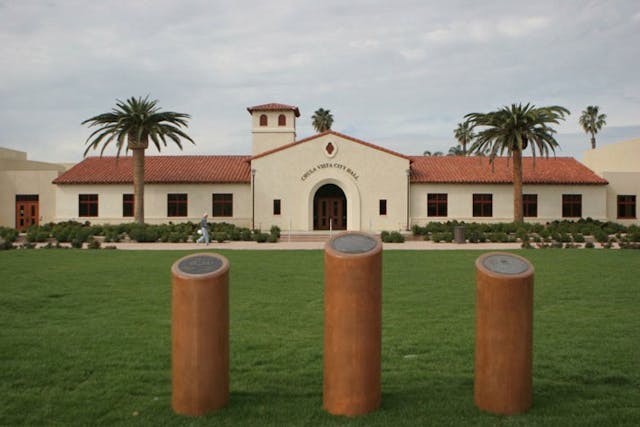School Beat: California’s Competing Tax Measures
Commentary:
By Lisa Schiff
California voters concerned with the fate of our public schools face a dilemma this election day–how to vote on the two competing tax measures that each pledge to provide significant new financial support to our state’s public education system. Propositions 30 and 38 present very different alternatives to the immediate fiscal crisis in our schools and formulating an opinion on them is no easy matter.
Proposition 30, “The Schools and Local Public Safety Protection Act of 2012,” was put forth by Governor Jerry Brown and is endorsed by both teachers unions, school districts and education related organizations. It promises, via a mix of higher income taxes and sales taxes, to provide increased funding to our public schools and ensure sufficient monies for targeted public safety services that have been pushed down to local levels. But the most significant aspect of this measure was that it was designed to prevent the automatic budget cuts that will be triggered in January should it not pass.
Stripped to bare reality, Proposition 30 represents nothing less than the unfinished business of the State Assemblyman Brian Nestande who had to resign from office because he voted for the bill to close corporate tax loopholes in order to provide revenue to stop UC tuitions from rising. The super-majority rule and the California Republican party have complete control over our state’s finances, forcing ballot measures to be the only viable alternative. Hence Proposition 30.
The provenance of Proposition 30 starkly reveals the structural flaws in our state’s financial system, but the struggle to fix that problem belongs to another day. The task in front of us is to decide if this measure is good for California right now–and it does have some qualities to recommend it. Besides eliminating the automatic budget cuts, Proposition 30’s biggest strength is that it taxes the right people, namely higher income earners making over $500,000 per year. Shifting the financial burden corrects a current imbalance in which lower-income earners pay a greater share of their earnings in taxes than do higher-income earners.
Another plus in this measure’s favor is that the additional money funds a variety of critical social infrastructure needs, including but not limited to, public education through the community college level. Sufficient funding for public education is a necessity, but so are public safety services and mental health services, which are among some of the other major categories of Proposition 30 funded needs. The challenges of public education now include challenges caused or exacerbated by a tattered social infrastructure.
While the new revenue sources would increase the general fund of the state, they would also go directly into a dedicated fund in that larger overall pot, and in the case of school funding, are supposed to go towards classroom expenses. This means that the revenue levels used to determine baseline education funding (which is a result of Proposition 98) will increase along with those revenues.
Further, the monies from the additional taxes are supposed to go to classroom, not administrative, needs. Of the new revenue, 11% will go to Community College needs and 89% will go to K-12 needs and at a minimum the funds will result in an additional $200 per K-12 pupil and $100 for each full-time community college student. The funding for public safety services will get distributed into local funds that counties are supposed to establish. Finally, the measure calls for a yearly audit, something we learned this year is all too clearly needed.
Of course Proposition 30 has some problems as well, the most concerning being its short term nature. The new income tax ends in seven years, but California needs a permanent structural solution to our fiscal problems. An enormous amount of work is going into passing Proposition 30 for such a temporary fix especially given that we have untapped revenue capacity (remember that corporate tax loop-hole that didn’t get closed).
Another major concern is that Brown’s measure includes a sales tax increase of 0.25%. This tax will expire in four years, but still, sales taxes disproportionately affect the lowest income earners since they spend a greater percentage of their income. A higher sales tax will strain the very families who need the financial support the most.
Finally, this measure’s funding scope is too narrow. Unlike the Millionaires Tax that got sacrificed for Brown’s plans, Proposition 30 ignores many other critical services that have been drastically cut, such as low-income health care. These significant needs of these programs will not be helped by Proposition 30.
If Proposition 30’s vision is less than broad, Proposition 38’s is laser specific. Known as “Our Children, Our Future” and created and funded by wealthy civil rights attorney Molly Munger, this measure has an exclusive focus on increasing public school funding. To that end it tackles early child education needs, K-12 requirements, and even education debt-servicing. Proposition 38’s major education backers are the California PTA and Tom Torlakson, California’s Superintendent of Public Instruction.
Proposition 38’s biggest strength is that it recognizes the dramatic underfunded of our public school system and attempts to fill that gap by an income tax increase. This measure ensures that the new revenue will augment, not supplant, the guaranteed base funding from Proposition 98 and targets the resources to classrooms, not administrative needs.
Proposition 38 also recognizes that the state has a budget deficit that needs to be addressed, and provides significant funding for debt service on bonds (addressing education related bonds first). During the first four years of Proposition 38’s span, 60% of revenues would go towards K–12 schools, 30% to repaying state debt, and 10% to early childhood programs. Thereafter, 85% of revenues would go to K–12 schools, and 15% to early childhood programs.
Proposition 38 has many controls to ensure that money is going as close to K-12 student needs as possible. Funding is tied to specific students through the allotment of “grants” from three different funds: a general fund for all students, with amounts varying by grade level and which comprises most of the money (70%); a low-income fund (18%) for students qualifying for free and reduced lunch; and a technology and training fund (12%), divided evenly across all students.
In addition to this relatively straightforward allocation method, Proposition 38 attempts to make school budgets accessible to the general public. To that end, the measure directs the State Superintendent of Public Instruction to establish a standard reporting format that districts must use and post on the web. While this doesn’t ensure that the reporting format is clear and comprehensible, at least it will be uniform, and there would be a single point of contact –the State Superintendent–to lobby for changes.
While more funding for schools is at face value a good thing, Proposition 38 is not without its share of serious weaknesses. The most concerning of which is its source of revenue. Proposition 38 imposes an income tax increase on everyone making more than $7,316 per year, so even the very, very poor among us will be contributing to this new pot.
Increasing the burden of public services on the backs of low-income earners is always hard to justify, but especially so in these rough economic times. For some of us, this single aspect of Proposition 38 is enough to make us vote against this measure.
There are other problems though too. Like Brown’s measure, it is short term, ending after 12 years. It only addresses education needs, when there are other critical services that have seen devastating cuts. Public education simply can’t afford being isolated and pitted against other social services– our needs are intermixed and interdependent.
Finally, Proposition 38 adds a host of requirements that are meant to hold school districts accountable, but are likely to only add cost and complexity to existing school community engagement processes already lacking in authenticity. This measure requires public hearings to determine how the funds are used and those decisions must be publicized, along with measures of evaluation and subsequent results. Having this level of process applied to just a portion of public school management and governance makes no sense. While better accountability is undeniably needed, legislating it this way seems unlikely to succeed, as we’ve experienced so clearly with similar federal requirements in No Child Left Behind.
Voters who take the time to read the text of each measure (30, 38) and the excellent pieces from the Legislative Analyst’s Office (30, 38) will discover one key component that Proposition 30 and 38 have in common–language to ensure that even if both measures pass, no aspect of the measure receiving fewer votes can be enforced.
According to the Legislative Analysts’ Office, the end result of this standoff is that if both 30 and 38 win, but Proposition 38 gets more votes, Brown’s automatic funding cuts will go into effect despite the extra income tax revenue 38 will generate.
The stakes are indeed high, high enough that some education supporters such as Educate Our State are encouraging Californians to vote yes on both measures to ensure that at least one of the two will pass. The strategy is understandable since our schools are unarguably past the financial breaking point. It is sickly ironic that at this truly desperate moment we are faced with not one but two potential solutions that together have the ability to sabotage the possibility of much needed increased resources.
Lisa Schiff is the parent of two children in the San Francisco Unified School District and is a member of Parents for Public Schools of San Francisco and the PTA. This article originally appeared on BeyondChron (www.beyondchron.org/news/)



 Arturo Castañares
Arturo Castañares


